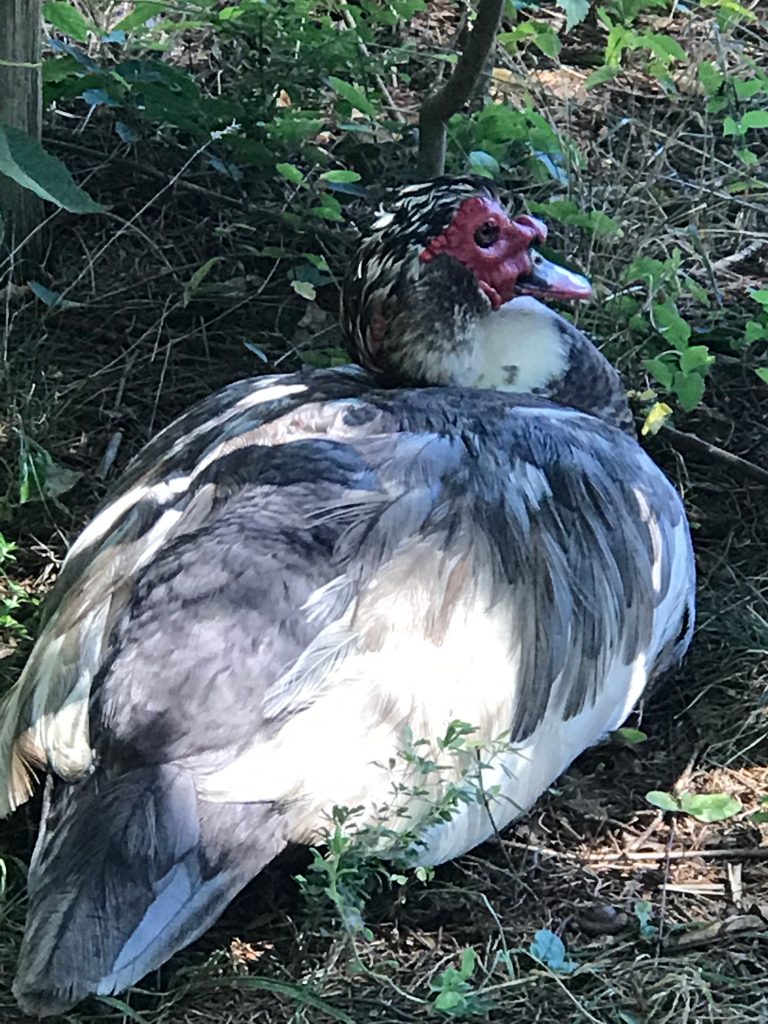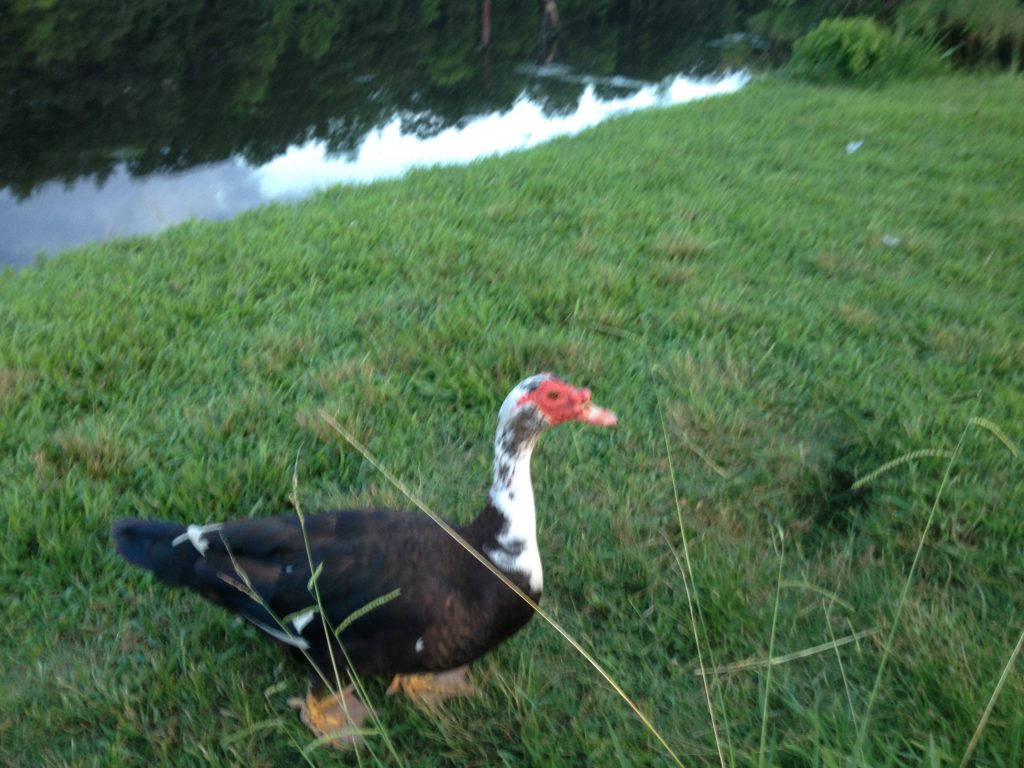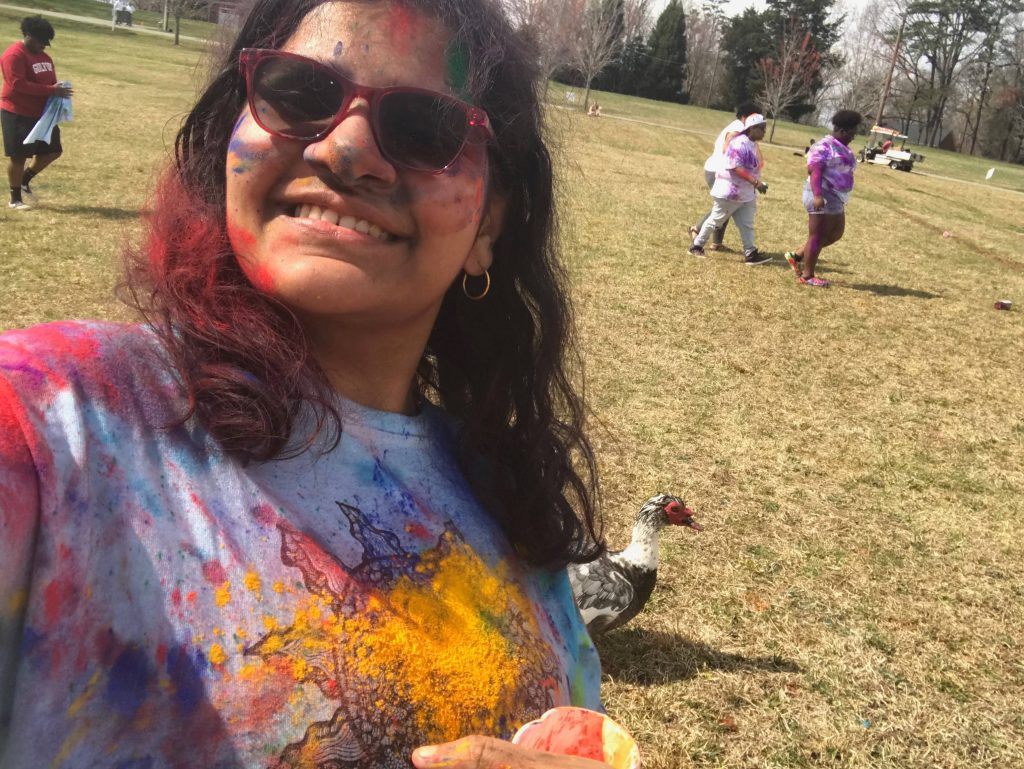
Nesting Muscovy Duck Hen 
The Muscovy Duck – Cairina Moschata 
Your intrepid author Ramya covered in colors, along with a super chill Muscovy Duck, enjoying the splendor and joy of Holi and Guilford College’s Serendipity Festival.
When I began chronicling my stories alongside the Canada Geese of Guilford College, I was astonished by how much I could remember of my experiences with them. What was supposed to be a single post detailing minutiae of waterfowl became a meander into memory lane, with experiential data of what it’s like to actually interact with Canada Geese, intimidating, but gorgeous birds. This post, in saving my favorite for last, will detail my experiences with the exuberantly curious and mostly friendly Muscovy Ducks! The Muscovy Duck, known as Cairina Moschata. The genus name, Cairina, originated from the mistaken belief that the birds were from Egypt (these birds are actually native to Mexico, Central and South America) and it means “the musky one from Cairo.” While “Muscovy” is also the old name for the area surrounding Moscow, it is really referring to the musky smell these birds possess, which Carl Linnaeus noted in 1746. They can be easily identified by their pimply, or as Linnaeus noted, “carunculated” faces, and by their speedy movements (their ducklings are mobile from birth). At Guilford, they often approach humans in pairs, and there seems to be a general consensus that there is a recognized duck couple (most likely, multiple) on campus. While their primary diet is grass, and judging by the tails in the air, small fishes and insects under water, my experiences have shown that they find college students the most delightful resource for nourishment of all!
During my first year, we had the Guilford games on the lawn near the lake, where residents of Milner and Binford – the two first-year dorms – competed in a series of agility and endurance based events. My new friend, Shania, a resident of Binford, and I went together, and after tiring of our lack of athletic prowess, we decided to sit by the Guilford College lake on the bench, eat the chocolate we had collected throughout the day, and just talk. The crinkle of unwrapping the chocolates was enough to summon two Muscovy Ducks, who seemed to have a twinkle in their eyes. We could hear the characteristic low breathy call of the drake, the male duck, as it came toward us with its companion (interestingly, Muscovy Ducks don’t really quack, hence the title of this post). We looked at each other; she was the girl who had been surrounded by mountains all her life, and I never ventured into the yard in fear of mosquitoes. Whatever our prior experiences with nature had been, we could not deny that it was now excitedly running to us demanding we surrender not only the chocolate, but also our preconceptions of the supposed divisions between humans and the natural world, which had no doubt been navigated by slaves, Quakers, and especially the Saura and Keyawee tribes before us. We bunched ourselves on the bench as we frantically tried to come up with an escape plan.
“We can’t give them the chocolate, can we?”
“No, of course not! Run!”
We veered off to the left, preemptively trying to escape their waddling legs, but when we turned around, the two Muscovy ducks were already waddling off into the sunset together. We watched them for a moment, and breathed a sigh of relief before bursting into peals of laughter. We had gotten through our first duck ambush together.
In my second year at Guilford, snow had blanketed the State of North Carolina in a major weather event referred to as “Snowpocalypse” (an exploration of snow in the woods will be written in a later post). My friends, Natalie, Momo, and I, decided to trek into the woods and observe the seasonal changes. Natalie had been eating a bag of thin Cheetos, while I was eating a puckeringly delicious clementine. As they were wont to do, our feathered friends eagerly approached us for snacks. Before we go any further, I think it is important to state, given that this is a nature blog that could inspire future denizens of the planet, that one should refrain from feeding wild animals. Our food gets processed so much that it’s really not safe for them to consume in high quantities. With that being said, both of us each threw down a single orange slice, and a Cheeto; the results are below. Please keep the video volume at a low level so as to not be deafened by my laugh, enjoy the show.
So basically, to summarize the video, the Muscovy Ducks loved the Cheetos, and even caught it midair. As for the clementine, I’m sure they desperately wanted to give it a chance, because they tried it repeatedly. But every single time they tasted it, they shook their head, as if they were saying, “NOPE. That’s not what we like. But maybe we’ve been too harsh?” And repeat.
I guess the acidity was a big reason they didn’t like it, most of the organisms they eat are probably either mostly neutral or slightly basic, given the algal content in the lake. We were pretty flabbergasted and in awe at the discerning tastes and very human-like actions of the Muscovy Ducks, more on our wintry adventures in a future post.